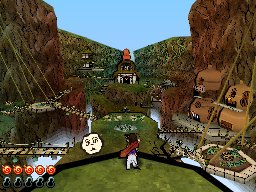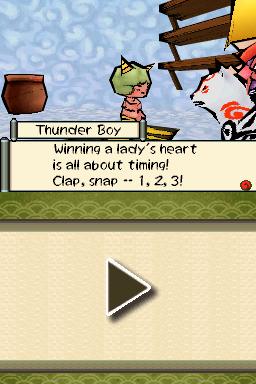GamesRadar+ Verdict
Pros
- +
Essentially a portable version of a classic
- +
DS is perfect for brush strokes
- +
Partners
- +
new abilities differentiate the game
Cons
- -
Lots of slowdown and stuttering visuals
- -
Dungeons
- -
combat are too straightforward
- -
Saying bad things about Okami
Why you can trust GamesRadar+
We’ve made no secret of our immense love for Okami, the latter-day PS2 adventure that perfectly copied Zelda’s best traits and slathered them with one-of-a-kind watercolor graphics. For years we begged the world to take notice and turn Okami’s unique world into a successful franchise, and at long last, a sequel has finally arrived. But instead of expanding the premise and building on what made the original so alluring, Okamiden essentially repurposes the first game for the DS audience. The result is a well-meaning but compromised version of a gorgeous, captivating world.

Like the original, Okamiden puts you in control of a weakened wolf deity who, once powered up, can use magical brush strokes to purify and heal the poisoned land. But this time it’s not Amaterasu who’s saving the day – enter Chibiterasu, Ammy’s adorable son who arrives just as Nippon begins to crumble. Like his mother, Chibi gains Celestial Brush techniques that damage enemies, summon sunlight and control the elements, each of which is activated by tapping L or R and literally drawing on the DS screen. This aspect is obviously well suited for DS, as the stylus gives you a tactile sensation missing from both the PS2 and Wii versions of Okami.
The powers themselves are a mixed bag. You’re using the same moves gained in the first game, so there’s little fresh or exciting about them, but Okamiden does a good job of giving you these powers early on. Compare that to Zelda or Metroid, which usually take hours upon hours to award familiar powers we’ve been using for decades. Still, we would’ve liked some kind of progression, like combining brush powers for new effects or at least a new wave of Chibi-specific moves that separated him from his mother. There are a couple of additions, but largely we’re dealing with repeats.
But it’s not all old material – Chibi isn’t quite as capable as Ammy, so he has to rely on a series of friends to help him exorcise the myriad demons clogging Nippon’s plains, skies and towns. In keeping with the adult-child motif, each partner is also a young version of an existing Okami character, be they direct descendants, servants or strongly suggested offspring. As the primary addition to Okamiden, these partners play a huge role both in gameplay and story.
Each partner has their own special battle ability, like slashing one enemy with a sword or playing musical notes to damage enemies all around. Seeing as Chibi’s own battle options are depressingly direct (Y-Y-Y-Y, brush slash, repeat) the partner moves help add a little spice to the combat.
Even then though, they’re not so clever or interesting that they made combat especially fun; some enemies require a bit more strategy to beat, and the towering bosses are even more elaborate, but by and large the fights became something we tried to avoid as often as possible, primarily because you gain more goodies for healing sick trees and fetching people’s missing belongings than you do for tackling every single enemy on the map. Okami’s about healing and helping, not endlessly fighting.
Far more useful are the helper’s out-of-battle abilities, where they hop off Chibi’s back and walk wherever you trace a line. One girl can see invisible platforms, another can emanate water from her body and douse flames, for example. Just like Zelda builds dungeons around the item you find in their depths, Okamiden structures its levels around the helper on your back, so you definitely put them to good use.
But it’s not all old material – Chibi isn’t quite as capable as Ammy, so he has to rely on a series of friends to help him exorcise the myriad demons clogging Nippon’s plains, skies and towns. In keeping with the adult-child motif, each partner is also a young version of an existing Okami character, be they direct descendants, servants or strongly suggested offspring. As the primary addition to Okamiden, these partners play a huge role both in gameplay and story.
Each partner has their own special battle ability, like slashing one enemy with a sword or playing musical notes to damage enemies all around. Seeing as Chibi’s own battle options are depressingly direct (Y-Y-Y-Y, brush slash, repeat) the partner moves help add a little spice to the combat.
Even then though, they’re not so clever or interesting that they made combat especially fun; some enemies require a bit more strategy to beat, and the towering bosses are even more elaborate, but by and large the fights became something we tried to avoid as often as possible, primarily because you gain more goodies for healing sick trees and fetching people’s missing belongings than you do for tackling every single enemy on the map. Okami’s about healing and helping, not endlessly fighting.
Far more useful are the helper’s out-of-battle abilities, where they hop off Chibi’s back and walk wherever you trace a line. One girl can see invisible platforms, another can emanate water from her body and douse flames, for example. Just like Zelda builds dungeons around the item you find in their depths, Okamiden structures its levels around the helper on your back, so you definitely put them to good use.
More info
| Genre | Adventure |
| Description | A spin-off to the quintessential "underappreciated gem," this Okami side-story features a puppy-sized version of the dog god and the child of two of the main characters in the first game. The art style, music and mechanics, while lifted from the earlier game, are still captivating and worthy of exploration, though we couldn’t shake the feeling this story would have soared higher on another platform. |
| Platform | "DS" |
| US censor rating | "Everyone 10+" |
| UK censor rating | "" |
| Alternative names | "Okamiden: Chisaki Taiyo","Okami Chronicles: Tiny Sun" |
| Release date | 1 January 1970 (US), 1 January 1970 (UK) |
A fomer Executive Editor at GamesRadar, Brett also contributed content to many other Future gaming publications including Nintendo Power, PC Gamer and Official Xbox Magazine. Brett has worked at Capcom in several senior roles, is an experienced podcaster, and now works as a Senior Manager of Content Communications at PlayStation SIE.




